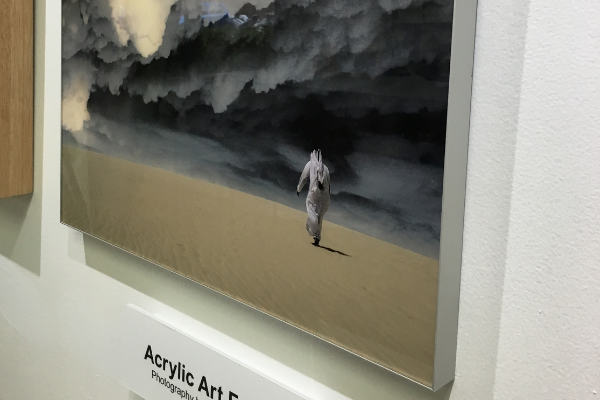How To Face Mount Photos To Acrylic

Acrylic Photograph Mounting – Function two: How To
Acrylic mounting is basically done with pressure rollers to mount the print to acrylic using an optically articulate adhesive, much similar image shown here. It'southward a straightforward process, but like everything, the devil is in the details.
Yous tin't make a adept cake without good ingredients and it'south the aforementioned with acrylic mounting and the most important ingredients for this process is the acrylic itself. The factors to look out for are clarity or light transmission (the more the better), haze (the less the better). This determines the acrylics transparency and optical brightness. UV inhibition is also important as this protects your image. There are specially treated acrylics with UV ratings of 99% plus, but they are expensive for general use – await for a good quality full general purpose acrylic which should take a 70% UV rating. There are also QC issues with all acrylics. Some examples are fine surface scratching, inclusions and impurities like infinitesimal black dots within the acrylic and impact marks on the surface. These are all possible issues from the manufacturer, but if you stick to the superlative brands, they can be avoided.
Printing type is almost of import in acrylic mounting. As a bones rule, the smoother the impress, the better result yous will get from the acrylic mounting. This is because texture in the print will show up as silvering which is minute air pockets trapped between print and acrylic – recollect putting glad-wrap over a plate of peas (lots of silvering) vs over a plate of jelly (no silvering). You can't necessarily run across the air pockets, but its being leads to loss of epitome quality. So, for good acrylic mounting, avert rag prints, lustre prints, etc and go for gloss or metal prints. One caveat is polyester based prints like Cibachrome, Fujiflex, etc. These are very smooth but are not suitable for acrylic mounting as polyester is a low surface energy textile which ways it doesn't stick very well using adhesives. There is a risk of bubbling, so avoid these types of prints.
You tin can't do good acrylic mounting without a clean environment. Dust, even minute particles are the enemy of this procedure. Don't forget, the mounting is irreversible, so whatever trapped dust is there for good. Acrylic mounting should be done in a clean room where dust is kept out and access restricted to technicians. All equipment in this room should exist kept clean and air movement to a minimal. If possible, air coming in should be filtered and have a positive pressure i.e. when you lot open the door, air should flow out, non in.
If you are creating acrylic wall panels, you lot will demand a backing put behind the impress as you should non attach hanging battens/frames straight to the back of the print. The most mutual methods are to use a metal composite like Dibond or a plastic sheet. The Dibond is stronger so you tin can use a thin acrylic like 3mm and create a sandwich structure. Plastic sheets don't have any rigidity, so a thicker acrylic similar 6mm is recommended. In conditions where there is a lot of thermal expansion/wrinkle (like Australia) be cautious of the Dibond/acrylic sandwich structure equally there is a big difference in the expansion rates between the metal and acrylic and over prolonged cycles, this may affect the mounting.
Our recommendation is to stick to the thicker acrylic/plastic back and strengthen the whole panel with a good subframe subconscious on back. Not only does this avoid any expansion effect, it looks ameliorate as the edges are polished acrylic rather than layers.
Share This Story!
Source: https://emergentdesigns.com.au/acrylic-photo-mounting-part-2-how-to/



0 Response to "How To Face Mount Photos To Acrylic"
Post a Comment